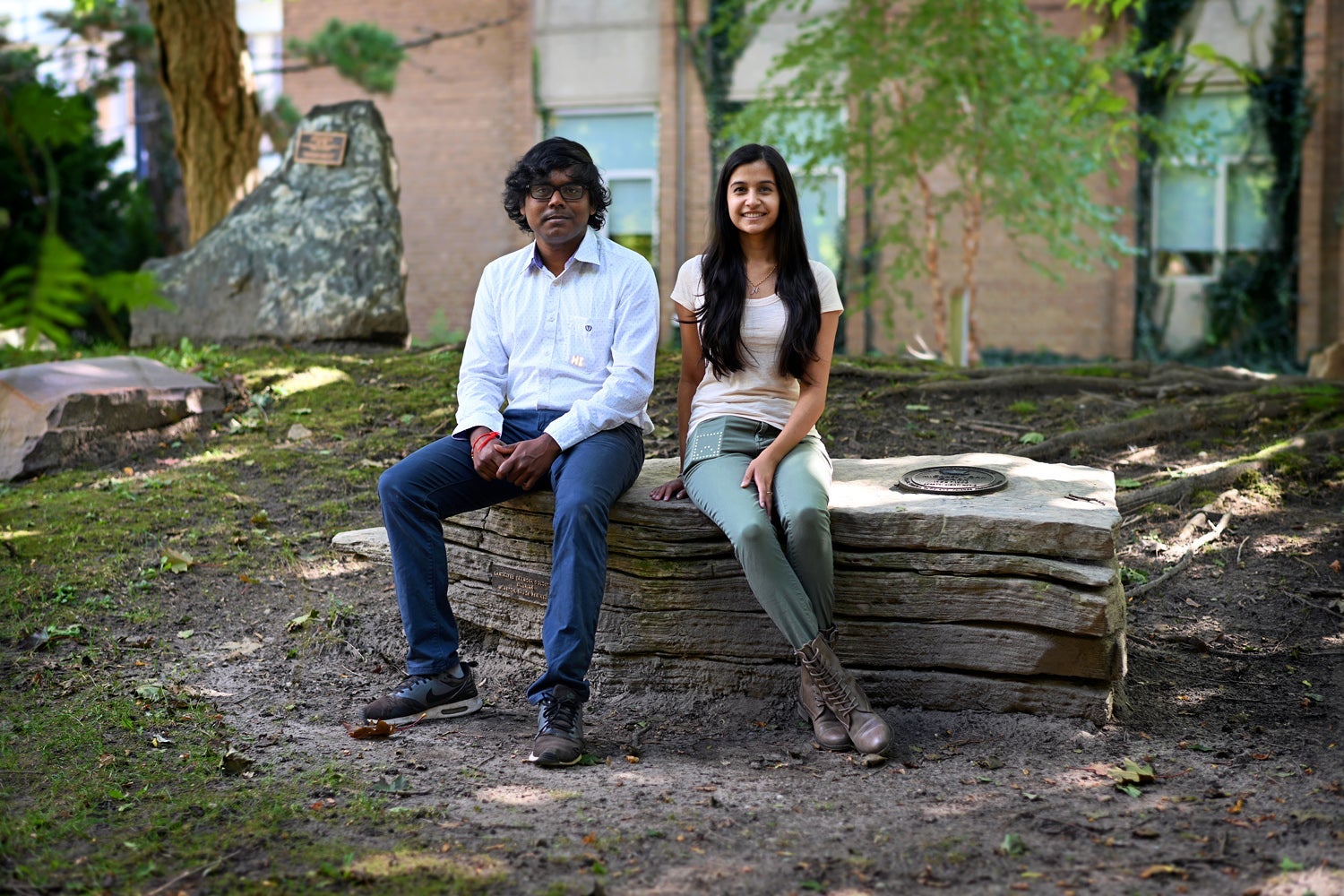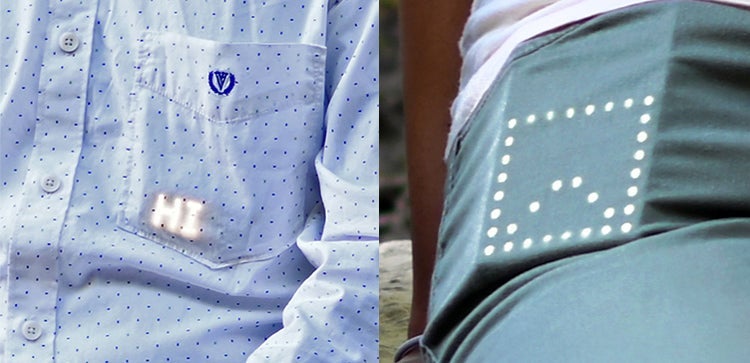Smartphones have become an indispensable part of our daily lives and because of their portability we bring them everywhere, but viewing information on our devices isn’t always convenient, safe or possible.
If your phone is tucked into a briefcase, backpack, pocket or purse, it must be removed or unlocked to see a message or notification. And digging through pockets and packs is awkward during meetings, difficult when carrying items, and possibly hazardous when running, biking or exercising.
Could basic smartphone information be made visible when your device is stored away?

L
to
R:
PhD
candidates
Antony
Albert
Raj
Irudayaraj
and
Nikhita
Joshi
from
the
Cheriton
School
of
Computer
Science’s
Human-Computer
Interaction
Lab.
In
Antony’s
shirt
pocket
is
a
car
remote–sized
device
prototype
displaying
HI,
a
message
to
initiate
or
encourage
social
interactions.
In
Nikhita’s
right
pant
pocket
is
a
phone-sized
prototype
displaying
a
mail
icon,
indicating
that
an
email
has
been
received.
That’s the question a team of human-computer interaction researchers at the Cheriton School of Computer Science explored. Their solution turned out to be transparently obvious — to display basic information by shining it through clothing.
The new technology — which the researchers have dubbed “PocketView” — uses bright, low-resolution LED arrays in devices of various pocketable sizes to display basic information. The displays can function either as a stand-alone device or be connected wirelessly to a smartphone using Bluetooth.

“We explored ways in which you can view information when your smartphone is in your pocket or another location,” explains Antony Albert Raj Irudayaraj, a PhD candidate at the Cheriton School of Computer Science. “The idea is not to show all the information that you would normally see on your smartphone display. These are displays that show minimal information. That’s good enough if you’re walking or biking, for example, to show basic navigation instructions. Or let’s say you received a message and don’t want to divert attention from what you’re doing. You can peek at the display and see the notification.”
Before the team created a variety of display form factors, they conducted an online survey of 112 people to understand their desire for information when a smartphone is tucked away, the variety and location of pockets people have on their clothing, and the types of objects stored in them.
The survey found that two-thirds of respondents wanted to access information on their smartphone when it’s not easily accessible. The survey also revealed that people wear clothing with pockets in a variety of locations and that they store many kinds of objects in them, most commonly phones, keys and fobs, masks and wallets. Some gender differences were revealed as well. Male respondents were more likely to carry larger items such as phones in their upper thigh pant pockets, whereas female respondents typically used a wider range of pockets across clothing to store their phones and other personal items.
“Some of the survey results challenged us to rethink the size, shape and functionality for the displays,” explained Nikhita Joshi, a PhD candidate at the Cheriton School of Computer Science. “The different sizes are important because so much women’s clothing has tiny pockets. A phone in the front pocket can be uncomfortable, so having something small just gives people way more options. We created a whole variety of form factors that would also be suitable for smaller pockets that are common in women’s clothing.”
Having determined that display devices of a variety of sizes and shapes would be desirable, the team then conducted light-transmission experiments to see if LEDs can shine through a range of fabric types, colours and weaves. As expected, thin and light-coloured fabrics had greater transmission, but the experiments also confirmed that many darker-coloured fabrics and denser weaves with patterns are transparent enough to see the lit LEDs beneath them, particularly indoors.
The original prototype the team created was a self-contained, battery-powered device with 64 LEDs in an 8 by 8 matrix, a device roughly the size of a phone. But based on the survey findings, the researchers also created pocketable prototypes the size of a pen, car remote key fob, earbud case and phone case. The goal was to construct devices that could fit easily into a range of pocket sizes, including the smaller ones often found on women’s clothing.

PocketView prototypes in different form factors — (a) an earbud case, (b) a pen, (c) a car key remote or fob, and (d) a phone case.
“A nice aspect of our work is that you don’t need to instrument the clothing itself,” Nikhita explained. “Your clothing can remain as is and it can be worn and washed as you like. Our approach of using a display that shines through fabric lets you wear your clothes as is and gives you a lot of freedom and flexibility where the display is kept.”
Although similar information can be displayed on a smartwatch, they remain expensive and far from ubiquitous. And even if someone wears a smartwatch, PocketView could be a complementary device to compensate for limitations. Antony explains, “If a smartwatch is covered by the sleeve of your jacket it might be hard to access when your hands are full.”
“A smartwatch is also worn on just one location,” Nikhita adds, “whereas these display devices can go on any location on your body that has a pocket, so it is a bit more diverse.”
The pocket displays can serve a variety of purposes. They can be used as notification assistants, perhaps providing navigation instructions while walking or biking; as fitness-tracking devices that show step counts, calories burnt, heart rate, or fitness goals; or as social displays to show a message to others — even medical notifications to indicate a potential emergency.

The
team
designed
simple
icons
to
convey
information.
The
numeral
5
(a)
shining
through
the
front
pocket
of
cotton
pants
could
indicate
minutes
before
a
meeting,
the
heart
icon
(b)
through
a
knit
dress
could
indicate
heart
rate,
the
mail
icon
(c)
shining
through
a
hoodie
indicates
that
email
has
been
received,
and
the
M
icon
(d)
shining
through
the
front
pocket
of
exercise
clothing
indicates
that
a
text
message
has
been
received.
Along with the practical side of the display devices and their capacity to show information and notifications in an easy way, the team is also interested in the new technology simply because it’s fun.
“Obviously we’re focused on the tech and programming side of the invention,” said Cheriton School of Computer Science Professor Daniel Vogel. “But even just as a fashion accessory, it’s something people told us they want. People could use it at clubs or in sports or in so many other ways. It’s such a simple thing but also such a radical idea that has so much potential. It also doesn’t require expensive, exotic electronics. Antony built and prototyped these devices in the HCI lab, and they could easily be put into production.”
To learn more about the research on which this feature is based, please see PocketView: Through-Fabric Information Displays, which was presented virtually at UIST 2021, the 34th ACM Symposium on User Interface Software and Technology.
Please
also
see
the
research
paper:
Antony
Albert
Raj
Irudayaraj,
Rishav
Agarwal,
Nikhita
Joshi,
Aakar
Gupta,
Omid
Abari,
and
Daniel
Vogel.
2021.
PocketView:
Through-Fabric
Information
Displays.
In:
Proceedings
of
the
2021
ACM
Symposium
on
User
Interface
Software
and
Technology
(UIST
2021).